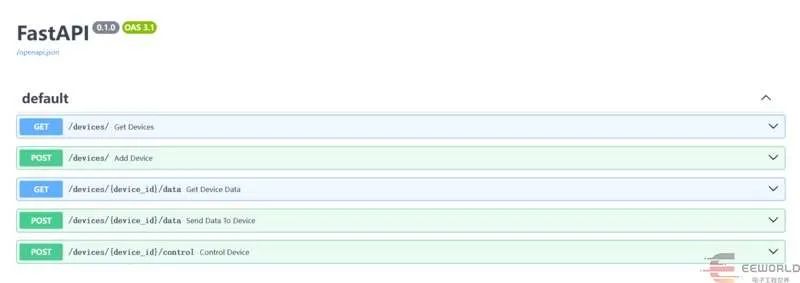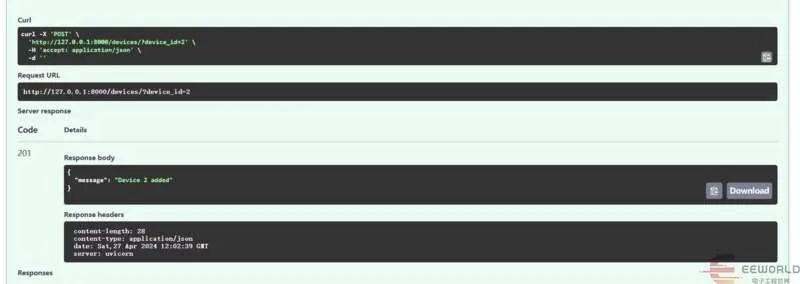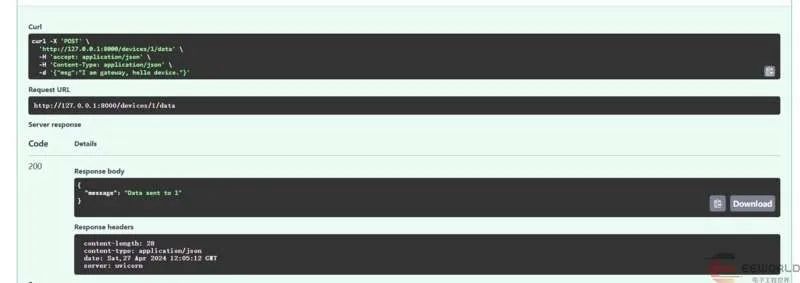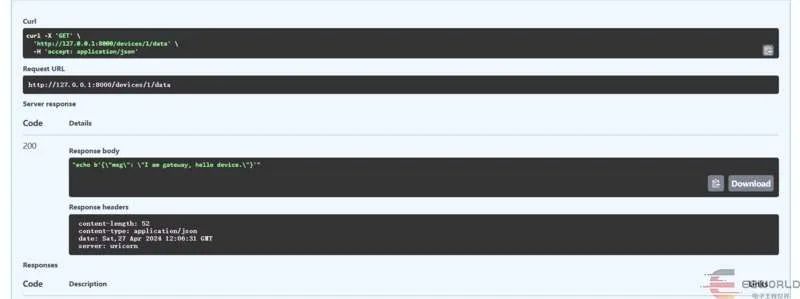

通过物联网管理多台MQTT设备-基于米尔T527开发板
描述
本篇测评由电子工程世界的优秀测评者“JerryZhen”提供。
本文将介绍基于米尔电子MYD-LT527开发板的网关方案测试。
一、系统概述
基于米尔-全志 T527设计一个简易的物联网网关,该网关能够管理多台MQTT设备,通过MQTT协议对设备进行读写操作,同时提供HTTP接口,允许用户通过HTTP协议与网关进行交互,并对设备进行读写操作。
二、系统架构
- 网关服务:基于FastAPI框架构建的Web服务,提供HTTP接口。
- MQTT客户端:负责与MQTT设备通信,管理设备连接、消息发布和订阅。
- 设备管理:维护一个设备列表,记录设备的基本信息和状态。
数据存储:使用内存或数据库存储设备数据,确保数据持久化。
三、组件设计
MQTT组件:
- 负责与MQTT broker建立连接。
- 订阅设备主题,接收设备发送的消息。
发布消息到设备,实现远程控制。
设备管理组件:
- 维护一个设备列表,记录设备的唯一标识符(如设备ID)、MQTT主题、连接状态等信息。
提供设备增删改查的方法。
HTTP组件:
- 基于FastAPI定义HTTP接口。
- 接收用户请求,调用MQTT组件和设备管理组件进行相应操作。
返回操作结果给用户。
四、接口设计
设备列表:
- GET /devices:返回所有设备的列表。
- POST /devices:添加新设备到网关。
DELETE /devices/{device_id}:从网关中删除指定设备。
设备详情:
GET /devices/{device_id}:返回指定设备的详细信息。
设备数据:
- GET /devices/{device_id}/data:获取指定设备的最新数据。
POST /devices/{device_id}/data:发送数据到指定设备。
设备控制:
POST /devices/{device_id}/control:发送控制命令到指定设备。
五、数据结构设计
设备信息:
- 设备ID (device_id):唯一标识设备的字符串。
- MQTT主题 (mqtt_topic):设备在MQTT broker上的主题。
- 连接状态 (connection_status):表示设备是否在线的布尔值。
其他设备属性(如名称、描述等)。
设备数据:
- 设备ID (device_id):关联设备信息的设备ID。
- 时间戳 (timestamp):数据发送或接收的时间。
数据内容 (data):设备发送或接收的具体数据,可以是JSON格式或其他格式。
六、安全性考虑
- 使用HTTPS协议提供安全的HTTP通信。
- 实现用户认证和授权机制,确保只有授权用户可以访问和操作设备。
对于敏感操作(如删除设备),要求用户进行二次确认或提供额外的安全措施。
七、部署与扩展
- 使用Docker容器化部署网关服务,便于管理和扩展。
根据需要,可以水平扩展网关实例以处理更多的设备连接和请求。
八、实现步骤
- 安装所需的Python库:fastapi, uvicorn, paho-mqtt等。
- 创建FastAPI应用并定义路由。
- 实现MQTT组件,包括与MQTT broker的连接、订阅、发布等功能。
- 实现设备管理组件,维护设备列表并提供增删改查的方法。
- 实现HTTP组件,调用MQTT组件和设备管理组件处理用户请求。
- 编写测试代码,验证网关的各项功能是否正常工作。
部署网关服务并监控其运行状态。
该设计方案仅仅是概述,具体实现细节可能需要根据实际需求和项目环境进行调整和优化。在实际开发中,还需要考虑异常处理、日志记录、性能优化等方面的问题。基于上述设计方案,以下是一个简化版的参考代码,展示了如何使用FastAPI和paho-mqtt库来创建一个物联网网关。需要注意,示例中不包含完整的错误处理、用户认证和授权机制,这些在实际生产环境中都是必不可少的。依赖的主要库版本:
fastapi==0.108.0
paho-mqtt==1.6.1
网关模拟代码gateway.py:
from fastapi import FastAPI, HTTPException, Body, status from paho.mqtt.client import Client as MQTTClientfrom typing import List, Dict, Any import asyncio import json app = FastAPI() mqtt_client = None device_data = {}
subtopic="gateway/device/#"
# MQTT回调函数 def on_message(client, userdata, msg): payload = msg.payload.decode() topic = msg.topic device_id = topic.split('/')[-1] device_data[device_id] = payload print(f"Received message from {device_id}: {payload}") # MQTT连接和订阅 def mqtt_connect_and_subscribe(broker_url, broker_port): global mqtt_client mqtt_client = MQTTClient() mqtt_client.on_message = on_message mqtt_client.connect(broker_url, broker_port, 60) mqtt_client.subscribe(subtopic) mqtt_client.loop_start() # MQTT发布消息 async def mqtt_publish(topic: str, message: str): if mqtt_client is not None and mqtt_client.is_connected(): mqtt_client.publish(topic, message) else: print("MQTT client is not connected!") # 设备管理:添加设备 @app.post("/devices/", status_code=status.HTTP_201_CREATED) async def add_device(device_id: str): device_data[device_id] = None return {"message": f"Device {device_id} added"} # 设备管理:获取设备列表 @app.get("/devices/") async def get_devices(): return list(device_data.keys()) # 设备管理:获取设备数据 @app.get("/devices/{device_id}/data") async def get_device_data(device_id: str): if device_id not in device_data: raise HTTPException(status_code=status.HTTP_404_NOT_FOUND, detail=f"Device {device_id} not found") return device_data.get(device_id) # 设备管理:发送数据到设备 @app.post("/devices/{device_id}/data") async def send_data_to_device(device_id: str, data: Dict[str, Any] = Body(...)): topic = f"devices/{device_id}" message = json.dumps(data) await mqtt_publish(topic, message) return {"message": f"Data sent to {device_id}"} # 设备控制:发送控制命令到设备 @app.post("/devices/{device_id}/control") async def control_device(device_id: str, command: str): topic = f"devices/device/{device_id}" await mqtt_publish(topic, command) return {"message": f"Control command sent to {device_id}"} # FastAPI启动事件 @app.on_event("startup") async def startup_event(): mqtt_connect_and_subscribe("127.0.0.1", 1883) # FastAPI关闭事件 @app.on_event("shutdown") async def shutdown_event(): if mqtt_client is not None: mqtt_client.loop_stop() mqtt_client.disconnect() # 运行FastAPI应用 if __name__ == "__main__": import uvicorn uvicorn.run(app, host="127.0.0.1", port=8000)
设备1模拟代码 dev1.py:
import paho.mqtt.client as mqtt
# 连接成功回调def on_connect(client, userdata, flags, rc): print('Connected with result code '+str(rc)) client.subscribe('devices/1')
# 消息接收回调def on_message(client, userdata, msg): print(msg.topic+" "+str(msg.payload)) client.publish('gateway/device/1',payload=f'echo {msg.payload}',qos=0)
client = mqtt.Client()
# 指定回调函数client.on_connect = on_connectclient.on_message = on_message
# 建立连接client.connect('127.0.0.1', 1883)# 发布消息client.publish('gateway/device/1',payload='Hello, I am device',qos=0)
client.loop_forever()
设备2模拟代码 dev2.py
import paho.mqtt.client as mqtt# 连接成功回调def on_connect(client, userdata, flags, rc): print('Connected with result code '+str(rc)) client.subscribe('devices/2')# 消息接收回调def on_message(client, userdata, msg): print(msg.topic+" "+str(msg.payload)) client.publish('gateway/device/2',payload=f'echo {msg.payload}',qos=0)client = mqtt.Client()# 指定回调函数client.on_connect = on_connectclient.on_message = on_message# 建立连接client.connect('127.0.0.1', 1883)# 发布消息client.publish('gateway/device/2',payload='Hello, I am device',qos=0)client.loop_forever()
运行网关代码,打开网页得到api接口: 通过api分别添加设备1和设备2,
通过api分别添加设备1和设备2, 在另外两个控制台中分别运行模拟设备1和模拟设备2的代码通过网页API向设备1发送数据
在另外两个控制台中分别运行模拟设备1和模拟设备2的代码通过网页API向设备1发送数据 通过网页API获得设备回复的数据,设备代码中只是简单的把网关发过来的数据进行回传
通过网页API获得设备回复的数据,设备代码中只是简单的把网关发过来的数据进行回传 我们在网关的后台可以看到完整的数据流
我们在网关的后台可以看到完整的数据流 至此一个简易的网关已经实现了,接下来将会尝试实现楼宇里的最常见的bacnet设备进行通讯管理。
至此一个简易的网关已经实现了,接下来将会尝试实现楼宇里的最常见的bacnet设备进行通讯管理。
-
快速部署!米尔全志T527开发板的OpenCV行人检测方案指南2025-04-11 15186
-
OpenCV行人检测应用方案--基于米尔全志T527开发板2025-04-10 1155
-
如何用OpenCV进行手势识别--基于米尔全志T527开发板2024-12-13 1819
-
FacenetPytorch人脸识别方案--基于米尔全志T527开发板2024-11-28 1437
-
【米尔首发-全志T527开发板-国产8核A55-免费试用】米尔全志T527开发板开箱验机2024-06-25 2768
-
通过物联网管理多台MQTT设备-基于全志T527开发板2024-06-21 1237
-
两款新品!基于全志T527的商显主板及工业微型控制器2024-06-13 2125
-
米尔-全志T527开发板评测试用-通过物联网管理多台MQTT设备 摘自:优秀试用者JerryZhen2024-06-11 2743
-
米尔全志T527开发板开箱验机2024-03-07 15468
-
全志T527国产核心板及米尔配套开发板批量上市!2024-02-23 1759
-
米尔这款首发的国产核心板批量上市了!全志T5272024-02-22 1994
全部0条评论

快来发表一下你的评论吧 !

